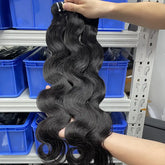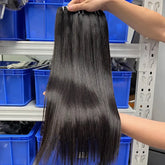Wig Export Industry: Hair Processing Insights - Yara Hair
The wig export industry has been growing rapidly in recent years, with a significant increase in demand for high-quality wigs. China, India, and Vietnam are the top three countries in the world that export wigs. Each of these countries has its own unique hair processing techniques, which sets them apart from each other. In this article, we will explore the key differences in hair processing techniques in the wig export industry of China, India, and Vietnam.
Hair Processing Techniques in China:
China has been a major player in the wig export industry for many years. Traditional Chinese hair processing techniques involve the use of chemicals such as bleach and dye to alter the color and texture of the hair. This results in a wide range of colors and styles that can be produced. However, the use of chemicals can also damage the hair, leading to a lower quality wig.
In recent years, China has also seen advancements in technology, which has led to the use of machines in hair processing. This has increased the efficiency and speed of production, but it has also raised concerns about the quality of the wigs. The use of machines can sometimes result in a less natural-looking wig.
Hair Processing Techniques in India:
India is known for its traditional hair processing techniques, which involve the use of natural ingredients such as henna, amla, and shikakai. These ingredients are known for their nourishing properties and are believed to improve the quality of the hair. Handmade wigs are also popular in India, with skilled artisans creating intricate designs and patterns.
The use of natural ingredients and handmade techniques results in high-quality wigs that are in high demand. However, this also means that the production process is slower and more labor-intensive, leading to higher costs.
Hair Processing Techniques in Vietnam:
Vietnam is a relatively new player in the wig export industry, but it has quickly gained recognition for its unique hair processing techniques. Vietnamese wigs are known for their softness and natural-looking appearance. This is achieved through the use of steam and heat to alter the hair's texture and color.
The use of steam and heat is a delicate process that requires skilled workers. This results in a higher quality wig, but it also means that the production process is slower and more expensive.
Key Differences in Hair Processing Techniques:
The key differences in hair processing techniques among these three countries can be summarized as follows:
China uses chemicals, India uses natural ingredients, and Vietnam uses steam and heat.
China and Vietnam use machines, while India relies on handmade techniques.
The use of chemicals and machines can result in a lower quality wig, while natural ingredients and handmade techniques produce higher quality wigs.
The cost of production is lower in China and Vietnam due to the use of machines, while it is higher in India due to the labor-intensive handmade techniques.
Cultural influences play a significant role in the choice of hair processing techniques in each country.
Conclusion:
In conclusion, the wig export industry is a highly competitive market, with China, India, and Vietnam being the top three countries in exports. Each country has its own unique hair processing techniques, which result in different qualities and costs of wigs. Understanding these differences is crucial for both consumers and businesses in the industry. With advancements in technology and changing consumer preferences, it will be interesting to see how these techniques evolve in the future.
FAQs:
Q: What is the most popular hair processing technique?
A: It depends on the country. China and Vietnam use machines, while India relies on handmade techniques.
Q: Are handmade wigs better than machine-made wigs?
A: It depends on personal preference. Handmade wigs are known for their high quality, while machine-made wigs are more affordable.
Q: How do cultural influences affect hair processing techniques?
A: Cultural influences play a significant role in the choice of hair processing techniques in each country. For example, India's use of natural ingredients is influenced by its traditional Ayurvedic practices.
Q: What is the future of the wig export industry?
A: With advancements in technology and changing consumer preferences, the industry is expected to continue growing and evolving.







